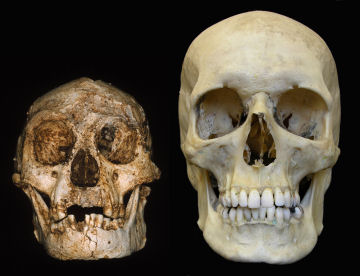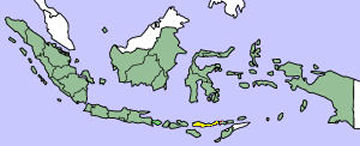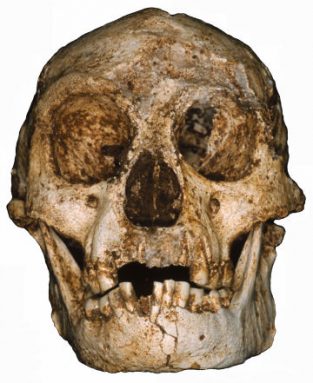A big discovery about little people
Humans may have once walked the Earth with tiny people—a possible newly discovered species that scientists have nicknamed "hobbits."
By Emily Sohn
Long ago, many species of humanlike creatures shared space on Earth. These different types of humans walked upright and had intelligent minds. At some point, however, all but one of those species went extinct. We, members of the species Homo sapiens (H. sapiens), were the sole survivors.
For years, scientists thought they knew when H. sapiens became the only kind of human species in existence. The scientists thought that the big change happened about 24,000 years ago, with the extinction of the Neandertals (Homo neanderthalensis).
Recently, however, scientists have found evidence of a previously undiscovered species of humans. The scientists made the find on the island of Flores in Indonesia.
 |
|
The skull of an adult person who lived long ago on the island of Flores (left) is much smaller than that of a modern human (right).
|
| Peter Brown |
The newly discovered species, called Homo floresiensis after the island of its discovery and nicknamed “hobbit” because of its tiny size, lived as recently as 12,000 years ago. Many scientists consider the hobbit to be the most important discovery in anthropology in 50 years.
The finds on Flores indicate that for thousands of years, “we were not alone as a human species,” says Bert Roberts, a senior research fellow at the University of Wollongong in Australia. “Until very recently, there would have been another type of walking, talking, interacting kind of human running around the planet,” he adds. Roberts was a member of the team that discovered H. floresiensis.
 |
|
Flores, shown here in yellow, is an island that belongs to the country of Indonesia. Other regions of Indonesia are colored green, and other Asian countries are shown in white.
|
| Wikipedia |
Finding hobbits
The first signs of the hobbit’s existence emerged in 2001, when a team of Australian and Indonesian researchers started finding small teeth and bones on Flores. The scientists were looking for H. sapiens fossils at the time.
At first, the scientists didn’t suspect anything unusual. They thought that the small fossils belonged to H. sapiens children.
Then, on the last day of the digging season in September 2003, an Indonesian researcher named Thomas Sutikna stumbled across what looked like the top of a skull in the ground. To protect the fossil, he dug out the entire block of sand surrounding it.
“It was only when he started uncovering what was in this block of sand that [the team] realized [he] had [found] a whole new human species,” Roberts says. Skulls often reveal more about a species than other bones can, he adds, and this skull was a clincher. “This really was something completely, remarkably new.”
The tiny skull looked different from any Homo skull ever unearthed. It had a sloping forehead and thick ridges above the eye sockets. It had a receding chin. Its brain—about 23 cubic inches in volume—was just one-fourth as big as a modern human brain.
 |
|
This photograph of a hobbit skull shows its distinctive sloping forehead and thick eyebrow ridges.
|
| Peter Brown |
Further excavations revealed that the creature’s skeleton was different from that of H. sapiens, too. The skull and bones belonged to a woman who was about 30 years old and about 3 feet tall—the size of a typical 4-year-old today. Her feet were flat and broad. And she had long arms, with hands that hung down to her knees.
Those features resembled those of some of our ancient ancestors who lived 2 or 3 million years ago, says Chris Turney, a research fellow at the University of Wollongong who became involved soon after the discovery. So, he expected the new fossils to be that old, too.
Much to everyone’s surprise, Turner’s analysis of the skeleton showed that the bones were just 18,000 years old. The hobbit was a completely new species of human. What’s more scientists had never seen anything like it living so recently. It was a huge discovery.
“I was blown away by this,” Turney says. “I just walked around with a great big grin all day.”
The great debate
The scientists announced their find in 2004. Some anthropologists, like Turner, were amazed by the news. But critics quickly disputed the findings. They claimed that the new skeleton was not a new species. It was simply a member of our own species suffering from a disease called microcephaly. Among other symptoms and deformities, people with microcephaly have smaller than average heads and bodies.
The debate gained steam. Meanwhile, further digging in the island’s limestone caves turned up bones from eight other hobbitlike people with similar bone structures. Analyses revealed that these individuals lived between 95,000 and 12,000 years ago, strengthening the case that the scientists had indeed discovered a new species. As Roberts says, it would be very unusual that an entire population would have microcephaly over that many years.
Most scientists do now believe that H. floresiensis was indeed a separate species from H. sapiens, Roberts says. “I’d say 99.5 percent [of scientists] are in our favor,” he claims.
But not everyone is convinced. Discoveries such as these shake up long-held theories about evolution. The discovery of H. floresiensis, for example, challenges the view of some experts that H. sapiens originated in Africa and then replaced all existing human species as it spread around the world. It suggests instead that H. floresiensis and H. sapiens actually shared the globe for tens of thousands of years.
Getting to the bones of the matter
Because of arguments between researchers, further excavations, which could answer the many remaining questions about the hobbits, stopped in 2004. But now, the anthropologists are ready to pick up their shovels again. This June and July, digging on Flores will resume.
The researchers hope to find more skeletons with features similar to those of H. floresiensis, as well as samples of DNA, which should “settle the dispute once and for all,” Roberts says. More fossils would also give more details about the lives of the hobbits.
Evidence to date suggests that the hobbits were clever, despite their small brains, Roberts says. Explorations of the sites where the bones were found shows that the hobbits used specialized stone tools. They hunted komodo dragons and pygmy elephants. They could make fires. And they found a way to travel to Flores, probably from the mainland of Asia, on their own.
Despite the enthusiasm of Roberts and many others, scientists still cannot prove that H. sapiens and H. floresiensis lived on Flores at the same time. Only more digging, and additional studies of the bones, will resolve this question.
Going Deeper:







